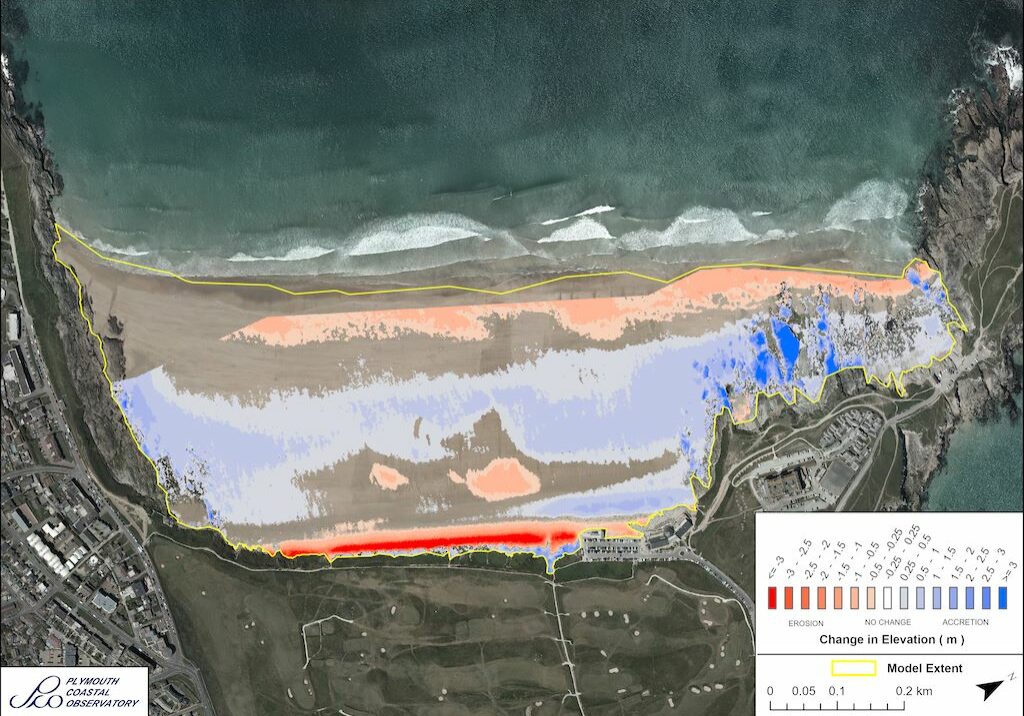
Fistral (Cornish: ‘Baya Fistal’, meaning ‘cove of foul water*’) is a west facing beach in north Cornwall, associated with the town of Newquay. Fistral is a wide bay fringed by the steep low cliffs of East Pentire Point to the south-west and Towan Head to the north-east.
The sediment associated with Fistral is fine to medium grained, with a high composition of shell fragments. Little and Great Toddy Cove, to the south of the site, is strewn with pebbles and cobbles. Almost the entire width of Fistral is dominated by a dune system. This system would have once extended further inland, but agricultural use, followed by the development of the town of Newquay and more latterly the development of a golf course, have constrained the dune to a thin strip above the uppershore of the beach.
The town of Newquay has developed and grown around the coastline, this initially focused on fishing and shipping and more latterly on tourism. Some of the development on either flank of Fistral is protected by coastal defence structures, but the majority of the beach remains unprotected.
*likely a reference to the waves that made it an unsuitable landing site compared to the calmer waters of Newquay Bay.


Coastal Change
The coastline of Cornwall is an ever-changing environment. It is energetic, dynamic, never still and changes with each wave and each tidal cycle. Some of the changes we see are gradual and barely noticeable, whilst others, such as rockfalls, happen suddenly and often shockingly.
From one visit to the next it can sometimes be difficult to see how a beach and dune system has changed, but information has been collected, and is being collected through the Making Space for Sand project, to help us better understand how the coastline is changing. The purpose of this section of the website is to understand each location has changed over time, how it could change in the future and understand the policies that influence how we can respond to these changes.
Shoreline Management Plans (SMP)
The Shoreline Management Plan (SMP) is a strategic planning and management assessment tool that helps identify and measure the risk associated coastal erosion and coastal flooding. The document makes a number of policy recommendations over short, medium and long term timeframes setting out a strategic approach to managing the built, natural and historic environments associated with the coastline. Within SMP there are four policy approaches which have been assigned to stretches of coastlines. The four policies are: No Active Intervention (NAI), Hold the Line (HTL), Managed realignment (MR), and Advance the line (ATL).
Fistral sits within Policy Development Zone 12 (PDZ12), in Management Area 31 (MA31), within Policy Units (PU) 31.1, 31.4, 31.5 and 31.6. The policy recommendations for these policy units are detailed in the table below and the SMP can be accessed through the Cornwall Council website.
Use your touchscreen
to scroll the below table
| Policy Unit | SMP2 Policy Plan | ||||
| 2025 | 2055 | 2105 | Comment | ||
| 31.1 | Undefended cliffs
Main Policy Sub Policy
|
NAI DnD |
NAI DnD |
NAI DnD |
Will meet high level objectives and satisfy AONB and heritage coast criteria. Allow natural coastal evolution to occur to support conservation of designated features.
|
| 31.4 | Pentire / South Fistral
Main Policy Sub Policy
|
HTL RnR |
NAI LAO |
NAI LAO |
Policy intent long term is to allow natural processes to occur as current defences deemed to be sufficient and current mapping indicates low erosion risk. However, HTL will need to continue in the immediate future to allow for monitoring to take place to access like likely recession and potential threat to cliff top and properties access point will need to be maintained due to safety.
|
| 31.5 | Central Fistral & Dunes
Main Policy Sub Policy
|
MR NF |
MR NF |
MR NF |
Intent of the policy is to not constrain the beach more than necessary as allowing for natural variability in the area as this is the best option for providing a wide beach frontage, which itself will provide protection from the high energy wave climate of the area. This would allow priority to be given to enhancement of the natural dune system as a UK priority BAP Habitat, whilst continuing to encourage natural and sustainable response to climate change impacts.
|
| 31.6 | North Fistral
Main Policy Sub Policy
|
HTL RnR |
HTL/MR RnR |
MR P |
Realignment and adjustment of the current shoreline position should be considered and planned for by 2055, possibly earlier. Policy is designed to protect the current infrastructure present as it is an important economic factor for the area. Maintaining current defence position is likely to become technically and economically unsuitable long term which is why policy intent is for MR long-term. Note, the adopted policy for the intermediate period is HTL / MR, indicating the timing of MR could be brought forward.
|
| Key Main Policy: HTL - Hold the Line, A - Advance the Line, NAI – No Active Intervention, MR – Managed Realignment
Sub Policy: DnD – Do not Defend, RnR – Repair not Replace, LAO – Local Activity Only, P - Placeholder |
|||||


National Coastal Erosion Risk Mapping (NCERM)
National Coastal Erosion Risk Mapping (NCERM) provides a baseline of coastal erosion, for the coastline of England, over short, medium and long-term timeframes. The data is based on the natural and defence characteristics of the coastline and provides rates of erosion at differing levels of confidence to help better plan for worse case scenarios. The data provided is for guidance and does not estimate the absolute location of the future coastline.
The basic NCERM lines show erosion estimates for the Short Term (ST-20 years), Medium Term (MT-50 years) and Long Term (LT- 100 years). The data is further categorised by probability: 05 is 5% probability (a 1 in 20 chance of being exceeded) Red Shading, 50 is 50% probability of being exceeded (a 1 in 2 chance of being either exceeded or not exceeded) Orange Shading and 95 is 95% probability (a 19 in 20 chance of being exceeded) Yellow Shading. Click the link below to access the Cornwall Council NCERM Mapping site read the about section then click on layers.

Historical Images of Fistral
Historical photographs provide a powerful insight into how the Cornish coastline has changed within the past Century. The Making Space for Sand project are working in collaboration with the Francis Frith collection and have been given permission to share historical images on a number of beaches considered within the project.
In looking back, we can better understand how the coastline has changed, helping us understand not only how the coastal fringe has developed but also the potential future changes that we my observe. When this is considered alongside forecasts of coastal erosion and sea level rise it will help enable us to better adapt to our changing coastline.
North Fistral from the cliffs of Towan Head, 1925 (Image courtesy of the Francis Frith collection) and in 2023.
South Fistral from Esplanade Green in 1959. (Image courtesy of the Francis Frith collection) and in 2023.

Modelling Coastal Change

Using data that has already been collected, combined with data collected through the Making Space for Sand project, a series of models will be carried out at each location. This will help us better understand how each location may respond to sea level rise and gain a deeper understanding of how coastal sediments move and behave.
The complexity of the modelling, and the data collection that helps inform it, means that modelling outputs will not be the same on all sites. Some locations will be more thoroughly investigated to understand more complex issues and provide data that can be more widely applied to other sites with similar characteristics.
As the project develops this section of the website will expand, sharing new reports and coastal change projections when they are produced.
LiDAR surveys, which are explained on the Data Modelling page, have been carried out by the South West Coastal Monitoring program at this location. The image shared here visualises where sand has eroded (areas shaded in red) and where it has built up (areas shaded in blue), between the LiDAR surveys carried out in 2003 and 2020. The darker the shade of red or blue the greater the amount of sand erosion or accumulation has been observed. The image helps visualise that beaches are areas that change shape over time and will continue to do so as sea levels rise.



Beaches and dunes represent an important transition between the marine environment and the terrestrial environment. This transition creates a range of special habitats and exposes a range of interesting features, which that can result in these spaces being highly designated and protected. The Making Space for Sand project will survey a number of dune systems. These surveys will help highlight how they may be changing, will identify rare species, will map invasive species, help us understand overall dune condition and identify potential constraints to improving their condition.
There are a range of designations that recognise a variety of different features. There are also a number of dunes systems where data has been collected to understand their habitat value. These are explored, on a site-by-site basis, in the section below.

Designations
Marine Conservation Zone (MCZ)
A Marine Conservation Zone (MCZ) is a type of marine protected area, designated in English, Welsh and Northern Ireland territorial offshore waters, to protect a range of nationally important, rare or threatened marine habitats or species by halting or reversing damage and degradation caused by human activities.
Image of a Celtic sea slug on the edge of a rockpool
Newquay and Gannel MCZ
The Newquay and the Gannel MCZ covers an area of 900 hectares, extending along the mean high water mark from Kelsey Head to Trevelgue Head. The MCZ protects a high variety of habitats and species. The habitats protected include exposed sandy beaches and rocky shores, where anemones, sponges and sea squirts can be found alongside important species such as the rare giant goby.
Image of a velvet swimming crab (Courtesy of Tony Sutton)

Beach Dune Management Plan
Many of the sand dunes and beaches around Cornwall’s coast are experiencing net erosion and sediment loss. This is due, in part, to lack of new sediment input to the shoreline system and rising sea levels. This is a pressing concern as these environments provide protection against the risk of coastal flooding, provide important habitats that cannot be easily recreated elsewhere if lost and help support the regions thriving tourism industry. It is therefore vital that the sand dunes and beaches around Cornwall’s coast are managed in a more sustainable way that balances the combined functions of beach-dune system.
In 2016, Cornwall Council produced Beach Dune Management Plans (BDMP’s) for 10 locations in Cornwall, including one at this location. The aim of the BDMP’s was to:
- Identify the best day-to-day management approach in terms of monitoring and intervention for the beach and dune system.
- Provide a longer-term approach to beach and dune management based upon an up-to-date understanding of coastal processes at the site, as well as predictions of future coastal evolution.
Where possible, the Making Space for Sand project will use these BDMP’s, supported by the data it collects, to work with landowners and environmental groups to help build more resilient and more biodiverse beaches and dunes that will help protect people and place from coastal erosion.
Sign up to Making Space for Sand
If you would like to get involved in helping to make dunes more resilient and biodiverse, want to help develop coastal adaptation and emergency plans or just want to know more about what the project is learning about coastal change, please click here:






